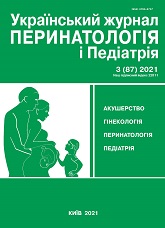Modern approaches for perinatal management in thrombocytopenia during pregnancy
DOI:
https://doi.org/10.15574/PP.2021.87.64Keywords:
pregnancy, thrombocytopenia, immune thrombocytopenia, gestational thromocytopeniaAbstract
The most common diseases of the blood system in pregnant women are anemia and thrombocytopenia (TP). There is a general tendency to significantly reducing of the number of platelets during pregnancy, starting from the first trimester with a minimum number of them during childbirth.
Purpose — to learn the features of motion of pregnancy, diagnostic and curative tactician at the thrombocytopenia during pregnancy.
The causes of TP during pregnancy are three groups of conditions — conditions for which TP is characteristic outside of pregnancy and conditions associated with pregnancy: gestational thrombocytopenia (GTP), pregnancy-specific complications, manifestations of diseases characterized by TP, with the chief reason among them — immune thrombocytopenia (ITP). The most common cause of TP during pregnancy is GTP, which, like ITP, is diagnose of exclusion that require differential diagnosis. The goal of treating TP during pregnancy is to achieve a safe platelet count that is different for each trimester, not target values. If the treatment of ITP is need lines of therapy with control of efficiency are consistently applied. Pregnant women with moderate and severe TP are a group of high perinatal risk, requiring careful differential diagnosis of the causes of TP, calculation of maternal and fetal risks, choice of tactics of such pregnancy, method and time of delivery, formation of postnatal care plan.
No conflict of interest was declared by the authors.
References
ACOG. (2019). Practice Bulletin No. 207: Thrombocytopenia in Pregnancy. Obstet Gynecol. 133: 181. https://doi.org/10.1097/AOG.0000000000003100
Davyidova YuV, Limanskaya AYu, Ogorodnik AO, Butenko LP, Bayder AK. (2017). Sovremennyie podhodyi k korrektsii trombotsitopenii vo vremya gestatsii i v poslerodovom periode. Zdorovia Ukrainy 21 storichchia. 11-12: 408-409.
George JN, McIntosh JJ. (2020, Apr). Thrombocytopenia in pregnancy. UpToDate.
Gernsheimer T, James AH, Stasi R. (2013). How I treat thrombocytopenia in pregnancy. Blood. 121 (1): 38-47. https://doi.org/10.1182/blood-2012-08-448944; PMid:23149846
Jamal S, Goel N, Mehta A, Ahuja M. (2017). Recurrent severe gestational thrombocytopenia in pregnancy: a case report. Int J Adv Med. 4: 1702-1705. https://doi.org/10.18203/2349-3933.ijam20175196
Kim BJ, Kim HS, Kim JH, Lee KY. (2017). Moderate to Severe Thrombocytopenia During Pregnancy: A Single Institutional Experience. Indian J Hematol Blood Transfus. 33 (4): 581-585. https://doi.org/10.1007/s12288-017-0784-1; PMid:29075073 PMCid:PMC5640537
Loustau V, Debouverie O, Canoui-Poitrine F, Baili L, Khellaf M et al. (2014). Effect of pregnancy on the course of immune thrombocytopenia: a retrospective study of 118 pregnancies in 82 women. Br J Haematol. 166 (6): 929-935. https://doi.org/10.1111/bjh.12976; PMid:24957165
Palta A, Dhiman P. (2016). Thrombocytopenia in pregnancy. J Obstet Gynaecol. 36 (2): 146-152. https://doi.org/10.3109/01443615.2015.1041893; PMid:26431056
Parnas M, Sheiner E, Shoham-Vardi I, Burstein E, Yermiahu T, Levi I, Holcberg G, Yerushalmi R. (2006). Moderate to severe thrombocytopenia during pregnancy. Eur J Obstet Gynecol Reprod Biol. 128 (1-2): 163-168. https://doi.org/10.1016/j.ejogrb.2005.12.031; PMid:16533554
Pavord S, Hunt B. (2010). The Obstetric Hematology Manual. Cambridge University Press. https://doi.org/10.1017/CBO9780511676451
Provan D, Arnold DM, Bussel JB, Chong BH, Cooper N et al. (2019). Updated international consensus report on the investigation and management of primary immune thrombocytopenia. Blood. 3 (22): 3780-3817. https://doi.org/10.1182/bloodadvances.2019000812; PMid:31770441 PMCid:PMC6880896
Rajasekhar A, Gernsheimer T, Stasi R, James AH. (2013). 2013 Clinical Practice Guide on Thrombocytopenia in Pregnancy. Washington, DC: American Society of Hematology.
Ramadan MK, Hubeich M, Itani SE, Mogharbil A. (2016). Severe Gestational Thrombocytopenia: A Case Report and Brief Review of the Literature. Journal of Hematology. 5 (4): 142-150. https://doi.org/10.14740/jh308w
Reese JA, Peck JD, Deschamps DR, McIntosh JJ, Knudtson EJ et al. (2018). Platelet Counts during Pregnancy. N Engl J Med. 379: 32-43. https://doi.org/10.1056/NEJMoa1802897; PMid:29972751 PMCid:PMC6049077
Reese JA, Peck JD, Yu Z, Scordino TA, Deschamps DR et al. (2019). Platelet sequestration and consumption in the placental intervillous space contribute to lower platelet counts during pregnancy. Am J Hematol. 94 (1): 8-11. https://doi.org/10.1002/ajh.25321; PMid:30328633 PMCid:PMC6447301
Rodeghiero F, Stasi R, Gernsheimer T, Michel M, Provan D et al. (2009, Mar 12). Standardization of terminology, definitions and outcome criteria in immune thrombocytopenic purpura of adults and children: report from an international working group. Blood. 113 (11): 2386-2393. https://doi.org/10.1182/blood-2008-07-162503; PMid:19005182
Sankaran S, Robinson SE. (2011). Immune thrombocytopenia and pregnancy. Obstet Med. 4 (4): 140-146. https://doi.org/10.1258/om.2011.110025; PMid:27579112 PMCid:PMC4989643
Webert KE, Mittal R, Sigouin C, Heddle NM, Kelton JG. (2003). A retrospective 11-year analysis of obstetric patients with idiopathic thrombocytopenic purpura. Blood. 102: 4306-4311. https://doi.org/10.1182/blood-2002-10-3317; PMid:12947011
Downloads
Published
Issue
Section
License
The policy of the Journal “Ukrainian Journal of Perinatology and Pediatrics” is compatible with the vast majority of funders' of open access and self-archiving policies. The journal provides immediate open access route being convinced that everyone – not only scientists - can benefit from research results, and publishes articles exclusively under open access distribution, with a Creative Commons Attribution-Noncommercial 4.0 international license(СС BY-NC).
Authors transfer the copyright to the Journal “MODERN PEDIATRICS. UKRAINE” when the manuscript is accepted for publication. Authors declare that this manuscript has not been published nor is under simultaneous consideration for publication elsewhere. After publication, the articles become freely available on-line to the public.
Readers have the right to use, distribute, and reproduce articles in any medium, provided the articles and the journal are properly cited.
The use of published materials for commercial purposes is strongly prohibited.

